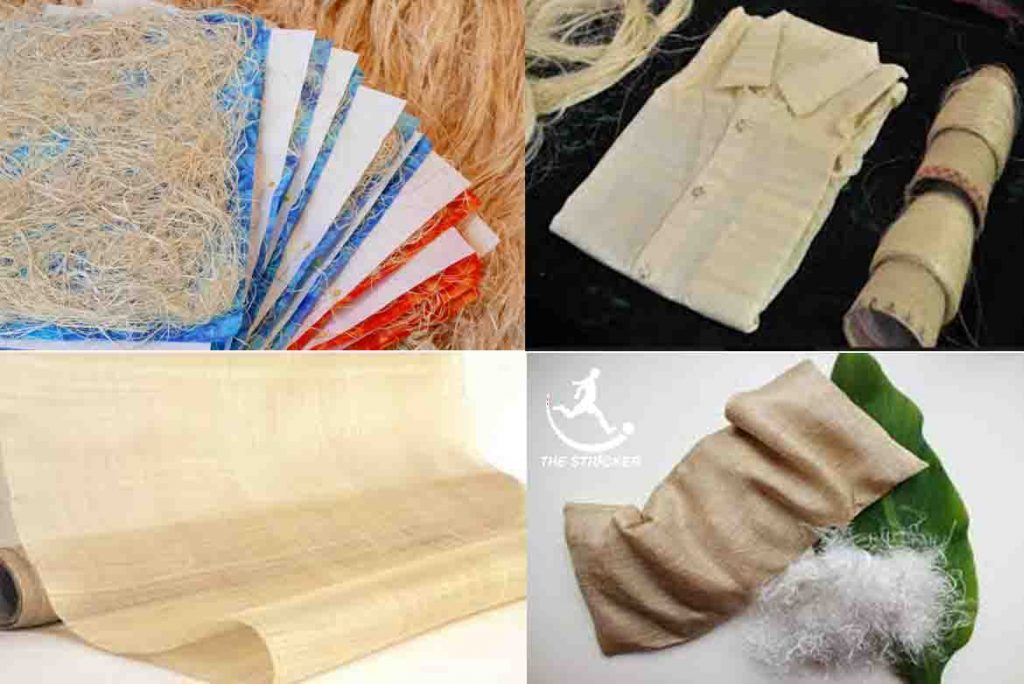
Introduction
Natural fibers have been used historically to produce our clothes’ carpets; cordage, paper, ship sails and insulation, and building materials. Banana Fibre is one of them. In this article the topic We will discuss:- Is it a Bast Fiber?
- Origin of Banana Fiber
- Banana Fiber Properties and Characteristics
- How Banana Fiber is Made
- Banana fiber yarn
- Banana fiber fabric
- Application and Uses
- banana fiber stool
- Banana Fiber Amazing Facts
Is it a Bast Fiber?
Banana fiber is a natural fiber. It is a lignocellulosic fiber. It is obtained from the pseudo-stem of the banana plant (Musa sepientum). So it is a bast fiber.Origin of Banana Fiber
According to archaeologists; the banana was first domesticated in the Kuk valley of New Guinea around 8,000 BCE. Though this is the first known location of banana domestication; other spontaneous domestication projects may have occurred throughout South East Asia and the South Pacific. Historically, banana stems had been used as a source of fiber with the earliest evidence dating to the 13th century. But its popularity faded after other convenient fibers such as cotton and silk were made popular. For centuries, banana fiber textiles were made in Japan and Nepal.Banana Fibre Characteristics
- Natural sorbent: Fabric from these fibers let you breathe well and will keep you cool on hot days.
Banana Fibre Properties
| Tenacity | 29.98 g/denier |
| Fitness | 17.15 denier |
| Moisture regain | 13 percent |
| Elongation | 6.54 |
| Alco-ben extractives | 1.70 percent |
| Total cellulose | 81.8 percent |
| Alpha cellulose | 61.5 percent |
| Residual Gum | 41.9 percent |
| Lignin | 15 percent |
Banana Fibre Production Process
Harvest
Cut 1 to 1.5 meter long pieces of banana fiber from the garden early in the morning or late in the evening when it is soft. If it is picked when it is too dry, it rips apart during preparation.2. Clean fiber
Wipe the banana fiber with a damp cloth to remove dirt.3. Straighten fiber
Hold fiber with one hand and with your other hand gently, but firmly; pull your palm along the length of fiber from one end of the fiber to the other.4. Peel fiber
Carefully peel off the waterproof layer from the surface of fiber (the “Intestine layer”) that will lie against the skin.5. Cracked fibers
If the fiber cracks near the middle, it cannot be used. If it cracks near edge; tear off the cracked edge (as long as remaining width is sufficient for user.)6. Fiber ready to use:
The fiber is ready for use once the waterproof layer that will lie against the skin is completely peeled off.Banana Fiber Application and Uses
Sanitary napkins from banana fibers
The International Institute for Environment and Development has even launched a program to educate women in Rwanda in making low cost and environmentally friendly sanitary pads out of banana fibers.Use of banana fiber in Japanese yen notes
During the research, it was found that the paper made out of this fiber has a shelf life of over 100 years and it can be folded as many as 3,000 times. The fiber has the potential to find application in the making of paper for printing currency.Use of banana fibers in car tires
The second-generation Mercedes-Benz A class designed the spare tire recess covered with a composite material, polypropylene, thermoplastic with embedded banana fibers, with high tensile strength and rot resistance. It can withstand stone strikes and exposure to the environment, such as UV from the sun, water, some chemicals.Banana Fiber Amazing Facts
1. Appearance of banana fiber is similar to that of bamboo fiber and ramie fiber, but its fineness and spinnability are better than the two.
2. The chemical composition of banana fiber is cellulose, hemicellulose, and lignin.
3. It is a highly strong fiber.
4. It has a somewhat shiny appearance depending upon the extraction & spinning process.
5. It is lightweight.
You may visit our shop: Leartex E-Shop
